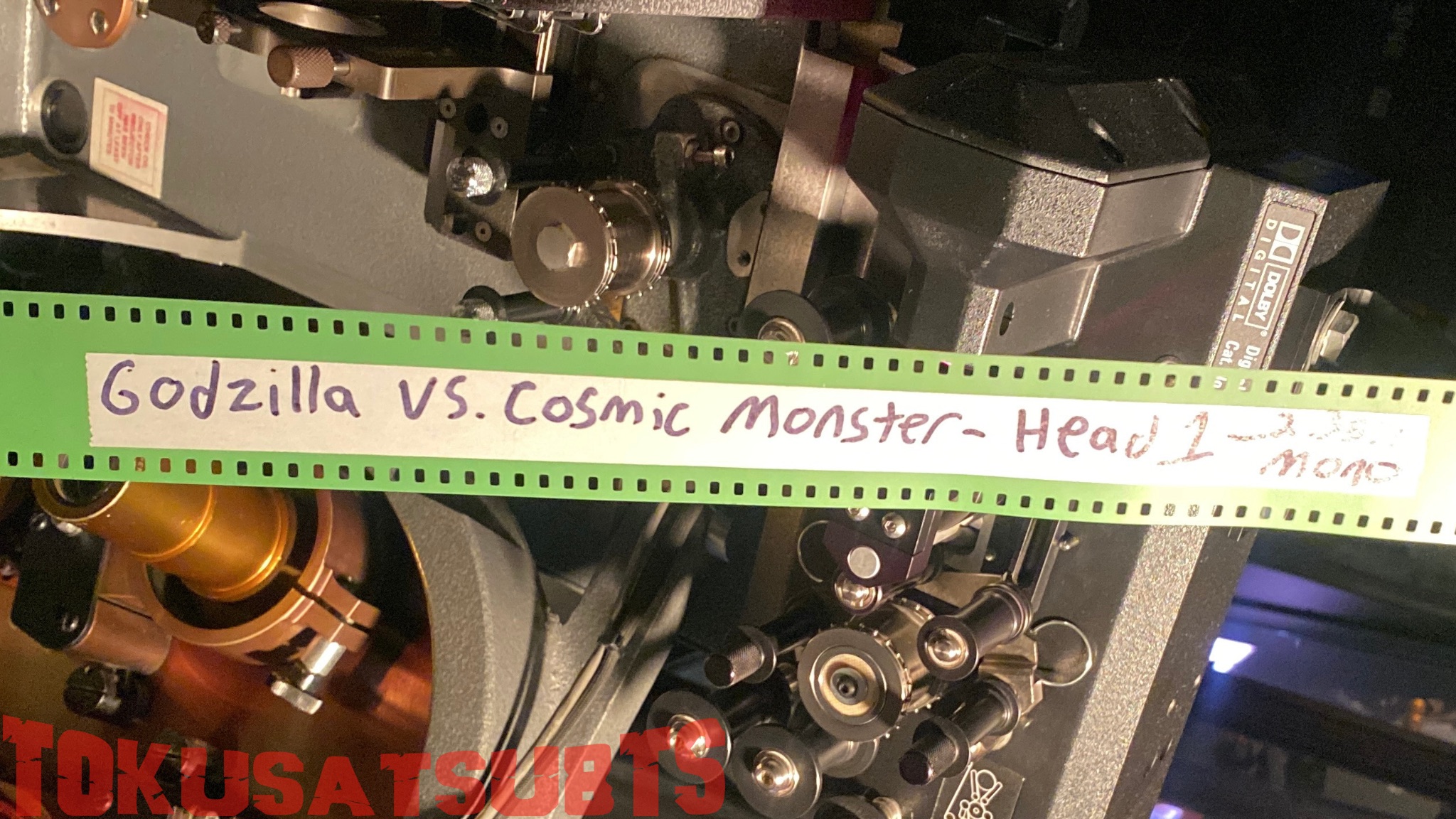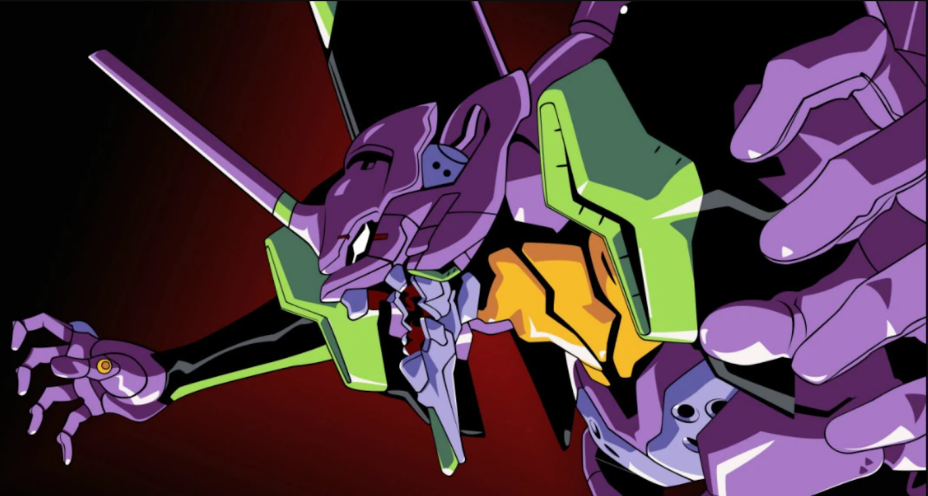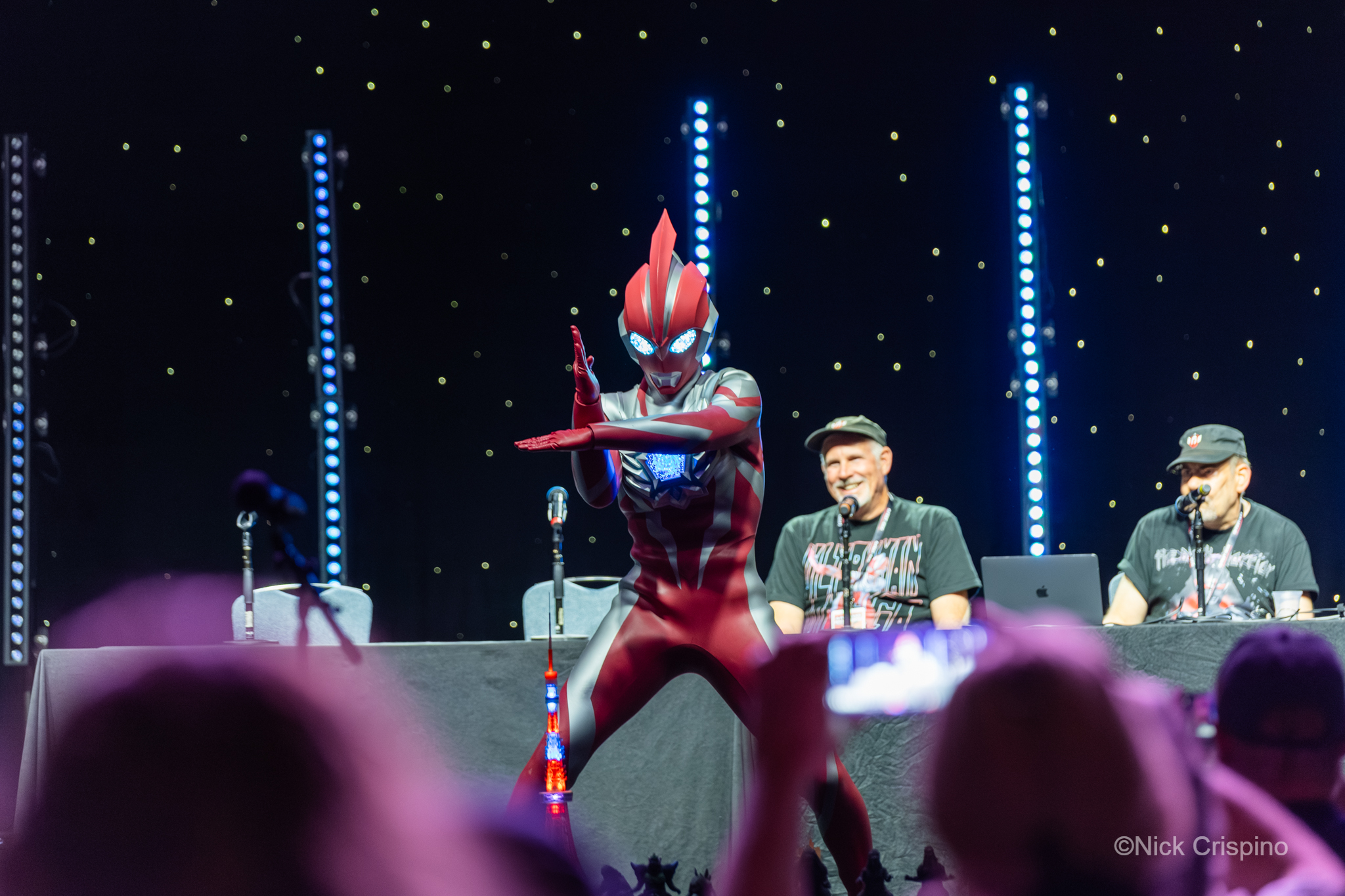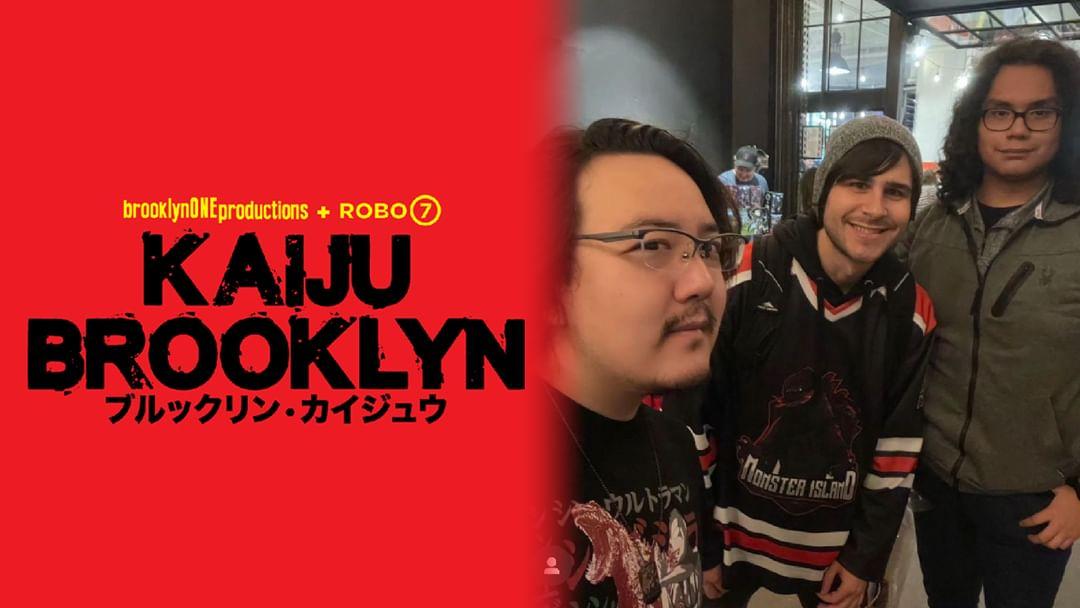On the night of April 16th, I had the rare privilege of attending a special 35mm screening of the original 1977 American theatrical release of Godzilla vs. Mechagodzilla presented under its U.S. title, Godzilla vs. The Cosmic Monster. This version has not seen proper circulation in physical media in the United States since 1998, when UAV released its final VHS edition in a white clamshell case. It briefly resurfaced in 2003 when the Australian company Siren Visual Entertainment issued a Region 4 DVD sourced from a 16mm pan-and-scan print.
For me, witnessing this rarely-seen cut (though this was likely screened at other events like the 2024 Mahoning Drive-In’s Godzilla-Palooza) was a tremendous experience!
Arriving early in hopes of catching a behind-the-scenes look at the projection booth, I was lucky enough to be granted access, thanks to a helpful employee at the venue. There, I met Baylee Johnson, the projectionist for the evening. She warmly welcomed me into her workspace, where I carefully observed Reel #1 being threaded onto the projector. Witnessing this firsthand gave me a true appreciation for the precision and dedication that film projection demands.
Baylee generously took the time to speak with me about her role and passion for analog film presentation:
Joseph: How did this screening come about? Was it up to the University of North Carolina School of the Arts (UNCSA) to give you the reels, or did you ask for them?
Baylee: The show we do here is called “Weird Wednesday”, usually programmed by Elizabeth Purchell. She loves kaiju films, so we do a lot of them. Also, Alamo has relationships with a lot of different archives and distributors, so whenever Liz or Jake, the repertory programmer, knows a print exists, they’ll reach out and arrange and show it. After that, they agree to a contract, and then they send it to me. They have someone inspect it beforehand to see what kind of condition it’s in before sending it out. I get it in, I inspect it to make sure the condition is good, and that when I send it back, if I mess anything up, then they can be like, “You messed that up!”. It happens pretty regularly. UNCSA seems to have a lot of the Godzilla movies, because that’s where we’ve been getting a majority of them.
Joseph: Were there any major goof-ups? You mentioned Godzilla vs. Megalon previously being out of order.
Baylee: I don’t think so, specifically with the Godzilla films, other than the Godzilla vs. Megalon incident. I didn’t run Godzilla 1985, but I did inspect it, and it was a lot more beat up than tonight’s and Megalon’s.
Joseph: Yeah, some scenes were skipped, it was crazy.
Baylee: Yeah, it was probably some kind of American version that may have come from a private collector. I’m not sure where that print came from, but I remember it was pretty beat up.
Joseph: How important do you think film projection is today? Is it a dying art? Do you think it’ll get fully replaced by DCP in the future?
Baylee: It has been replaced in a lot of places by DCP. That’s why I like New York, because we have two film houses, we have a 70mm show going on right now of Sinners, and then I’ll be running this [Godzilla vs. Mechagodzilla] at the exact same time. I hope film becomes less like a niche thing. Because there aren’t many jobs in projection, and a lot of people are interested in it, but there’s not a lot to go around. So it’d be really cool if it got bigger, and then we could have more young people to get involved.
Joseph: I have a few Super 8 films, but I have to buy a projector and all that.
Baylee: Yeah. I mean, the Super Eight projectors you could buy at Goodwill. I have a couple of them.
Joseph: Really? Sadly, I’ve had no luck with my Goodwill.
Baylee: Honestly, we have big filmmakers like Paul Thomas Anderson and Christopher Nolan to thank for making 70mm very popular, and I like that there are new releases coming out on film that were actually shot on film.
Joseph: Are there any other Kaiju events coming up soon?
Baylee: I do not know. I think the programming for May is still being finalized, so that schedule should come out in the next week or so, and that will have all of the Weird Wednesday movies, which is usually when we play any Godzilla films. Did any Godzilla movies come out in 1975?
Joseph: Yes, Terror of Mechagodzilla.
Baylee: We might be playing that, because I know next month we’re doing a 1975 retrospective. So we might be playing something for that. I’m not sure. I haven’t seen the list yet.
Joseph: Fingers crossed!
Baylee: Yeah! But I’ll let the programmer know that we have a big kaiju fandom and that we should be playing more Godzilla.
Joseph: Yeah, this one’s almost sold out, last time I checked.
Baylee: Yeah, yeah, I think so!
Joseph: Thank you so much for giving me this opportunity. I appreciate it.
Baylee: Of course. Interestingly, this screening is actually my 100th analog film I’m projecting tonight.
Joseph: Ah! Congratulations!
Baylee: I’m excited for it! I hope it goes perfectly.
After our conversation, Baylee introduced me to Paul Crucero, the evening’s presenter. Paul, a longtime advocate for analog screenings, gave a thoughtful and informative introduction that contextualized the film within its historical framework.


Right after the screening, I also had a chance to interview Paul!
Joseph: Could you please introduce yourself to us?
Paul Crucero: Hello! My name is Paul Crucero. I’m a New York City-based projectionist and film programmer, and I just introduced Godzilla vs. Mechagodzilla on 35mm for Alamo Drafthouse’s Weird Wednesday series of screenings.
Joseph: How did you get started as a projectionist? Because, as someone like me, I love film and I love watching stuff on film, and would love to get more involved in this field. How can one become a projectionist to continue this art form that’s currently losing, I guess, in some way, popularity?
Paul: That’s a great question, Joseph. My first job ever was at a movie theater. It was at the Pavilion Theatre, which is now the Nitehawk Cinema in Prospect Park. I worked there as floor staff initially… it sounds like a boring kind of pathway, but I worked my way up through different movie theaters, getting to know the projectionists. The way to the projection booth is a little harder than just studying for it or something like that. You kind of have to be at the right place at the right time. It’s kind of like – and I hate to say this – but if you’re on the good side of the projectionist, the projectionist wants to, like, bring you up and show you the ropes, that’s the only way you can learn. Well, it’s not the only way to learn projection, but it’s by far the most common way of getting your hands on projectors.
So that’s how I did it. I started off at The Pavilion, and then I worked my way up to getting to know the projectionist at the Brooklyn Academy of Music (BAM). The projectionist there taught me how to run simplex machines, 35mm film. These days, there are programs where you can learn projection, that Mono No Aware runs in downtown Brooklyn. They teach you 16 millimeter film basics. I instruct that class. Also, Spectacle Theater out in Williamsburg also entertains some open house ideas for projection. I also run those in collaboration with the head of that, Stephen Cappel.
Joseph: Where can we find more info about this?
Paul: You can check out Spectacle Theater at their website, and our contact information should be on the site. You can always give us a shout-out and mention that Paul the projectionist sent me. We’ll usually promptly respond. I’m also open to, like, one-on-one teaching sessions. So yeah, if anyone over at Kaiju United is interested in that, send it along and mention me. I’m happy to help any New York City-based person who wants to learn. I’m not a gatekeeper!
Joseph: I will greatly consider that. So obviously, this cut of the film is heavily censored for the G rating. What do you think of it? Was it perfect, or did it ruin some moments, conflicting with Jun Fukuda’s original vision for the film?
Paul: I grew up on this version released on VHS. I believe it was Simitar or a similar company that released it on VHS, and I grew up on the English dub. Only years later did I watch the original cut in Japanese, and this is the second time I’ve seen it on 35mm. I do think that this cut is a little jankier for lack of a better word – there were some cuts that I don’t think Fukuda envisioned when he was shooting the film, but I think it definitely adds to the story of the campiness and getting that G rating and localizing it for U.S. audiences at the time.
It’s a fun print, but I would by no means call it the definitive cut. Of course, you know, the dub versus sub debate always rages on. There’s a special place in my heart for dub movies, especially kaiju movies. But, I mean, I can never say that, you know, dubs are superior to subtitles because, I mean, you got to hear the film in the original language it was made in.
Joseph: Last one before we all got to go. What’s your favorite kaiju movie?
Paul: My favorite kaiju movies are almost exclusively Godzilla films. Although, I do watch Gamera; I watch the Rebirth of Mothra Trilogy. I watch all sorts of kaiju films, but I’m really like a Godzilla specialist… if you can indulge me to share my top five?
Joseph: Yes, go ahead.
Paul: Number one, definitely the 1954 original Gojira. I mean, that can’t be topped. You know, it being an allegory for a nation processing its national trauma. It’s amazing. Second would be Shin Godzilla. So good. Godzilla came back with a vengeance. Three would be Godzilla vs. Destoroyah, which is the end of the Heisei series. Very emotional ending. Four would be Godzilla vs. Biollante; very big fan of that. Love that plant-Godzilla hybrid kind of genetic mutation & abomination. Finally, the fifth would be the movie we just saw, Godzilla vs. Mechagodzilla. And if anybody was wondering just missing in my top five, number six would be Godzilla Minus One, which is a great movie, but it just misses, in my opinion.
Joseph: I feel like Minus One has overshadowed Shin Godzilla in a lot of ways.
Paul: Oh, yeah, yeah. I mean, it’s much more accessible than Shin, because anybody could kind of like, watch it and enjoy it without really knowing much of the lore. So it’s a great entry point for new fans. But Shin Godzilla, I think, is for me the superior Godzilla. Hideaki Anno just creates this very frenetic narrative about genetic mutability. It’s one of the coolest, Sci-Fi kind of setups with Godzilla evolving within a single generation. I mean, that’s scary. But yeah, I mean, Minus One is still great. I’m looking forward to Takashi Yamazaki’s next Godzilla film, which is greenlit. It’s gonna be a direct sequel to Godzilla Minus One, so we’ll see how it goes!
Joseph: Would you have wanted a sequel to Minus One or a sequel to Shin [Godzilla]?
Paul: Oh, both. Why not both? That’s my answer, to not piss off anybody. Minus One is definitely a film where a sequel was probably gonna be more accessible, whereas, if Shin Godzilla ever gets a sequel, it may be more complex. The end of that Godzilla is just in the middle of Tokyo just in statue form. We know that cliffhanger ending of him achieving his fifth form, which is kind of like, you know, Godzilla’s response to being defeated by a committee of creatures, human beings. So, who knows what the fifth form of Godzilla is after that mutation? I don’t know, it could go in a lot of scary places, and that’s the beauty of it.
Joseph: Paul, thank you so much for being here and talking Godzilla with me.
PC: Thank you so much, Joseph.
As the lights dimmed and the static hum of the audio came to life, the screening began with the Anguirus pre-title sequence. The full scene plays out intact up until the volcano eruption, at which point, the screen turns bright red and the film title appears, accompanied by the Basil Gogos poster artwork on the right! This is a detail that was cropped out in the VHS releases of the film.

Photo courtesy of Wikizilla

Photo courtesy of Wikizilla
While the print clearly showed its age with the faded colors and scratches, it gave more of a charm to the presentation! Minor audio sync issues were also noticeable, but were quickly corrected a few frames later. These imperfections only enhanced the authenticity of the experience!
Revisiting the ‘Cosmic Monster’ Cut
This cut uses the same export dub that’s been heard on Sony’s 2004 DVD and the Criterion Blu-Ray disc, the difference just lies within the edits. Scenes were restructured to preserve a G rating, eliminating strong language and more “graphic” moments. Here are some standout changes, compared side-by-side with the Criterion Blu-ray and a rip of the Siren Visual pan-and-scan DVD:
- Opening: The opening credits were removed, and a new title card was created, which would later cut to Princess Nami singing.
- Kuronuma’s Line: The line “Damn Godzilla” was censored by cutting the “damn.”
- Masahiko’s Dialogue: The line “I wanna go inside with you” was spliced with Nabara’s line about going back to Azumi Castle and cutting off “and I’m gonna take care of those bastards”, creating a very poor edit.
- Cave Edit: A scene where Nanbara’s strangulation of the alien was cut short to briefly show Shimizu, Saeko, and Ikuko’s arrival at Azumi Castle, only for them to cut back to the Alien revealing his form.
- Final Shootout: The scene of Kuronoma bleeding out was cut, replaced with shots of him falling alongside the other aliens.
- Ending Epilogue: Princess Nami returning the King Caesar statue was omitted, leading to an awkward cut from Caesar entering the castle, which then abruptly fades into a red “THE END” bar on screen.
Seeing Godzilla vs. The Cosmic Monster on the big screen was grand! I’m a huge fan of this dub, and all dubs in general, and seeing another one on the big screen is always a pleasure, especially on film! Hopefully, more theaters start doing events like these; it brings together people who enjoy the passion of Tokusatsu and monsters in general. Huge thanks to Baylee Johnson, Paul Crucero, and the team at Alamo Drafthouse for making this screening possible. And a big congratulations to the Alamo team for their huge victory in regaining all jobs! Remember to tip your servers and bartenders! Solidarity forever!
See you soon. Bye-bye!









